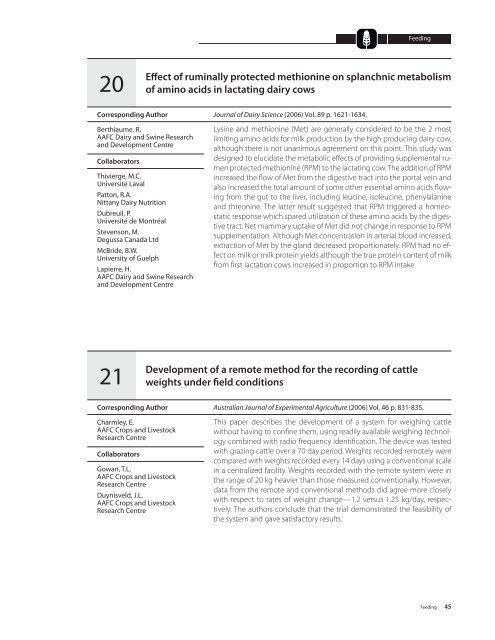A52-75-2007E.pdf - AgroMedia International Inc
A52-75-2007E.pdf - AgroMedia International Inc
A52-75-2007E.pdf - AgroMedia International Inc
You also want an ePaper? Increase the reach of your titles
YUMPU automatically turns print PDFs into web optimized ePapers that Google loves.
Feeding20Effect of ruminally protected methionine on splanchnic metabolismof amino acids in lactating dairy cowsCorresponding AuthorBerthiaume, R.AAFC Dairy and Swine Researchand Development CentreCollaboratorsThivierge, M.C.Université LavalPatton, R.A.Nittany Dairy NutritionDubreuil, P.Université de MontréalStevenson, M.Degussa Canada LtdMcBride, B.W.University of GuelphLapierre, H.AAFC Dairy and Swine Researchand Development CentreJournal of Dairy Science (2006) Vol. 89 p. 1621-1634.Lysine and methionine (Met) are generally considered to be the 2 mostlimiting amino acids for milk production by the high producing dairy cow,although there is not unanimous agreement on this point. This study wasdesigned to elucidate the metabolic effects of providing supplemental rumenprotected methionine (RPM) to the lactating cow. The addition of RPMincreased the flow of Met from the digestive tract into the portal vein andalso increased the total amount of some other essential amino acids flowingfrom the gut to the liver, including leucine, isoleucine, phenylalanineand threonine. The latter result suggested that RPM triggered a homeostaticresponse which spared utilization of these amino acids by the digestivetract. Net mammary uptake of Met did not change in response to RPMsupplementation. Although Met concentration in arterial blood increased,extraction of Met by the gland decreased proportionately. RPM had no effecton milk or milk protein yields although the true protein content of milkfrom first lactation cows increased in proportion to RPM intake.21Development of a remote method for the recording of cattleweights under field conditionsCorresponding AuthorCharmley, E.AAFC Crops and LivestockResearch CentreCollaboratorsGowan, T.L.AAFC Crops and LivestockResearch CentreDuynisveld, J.L.AAFC Crops and LivestockResearch CentreAustralian Journal of Experimental Agriculture (2006) Vol. 46 p. 831-835.This paper describes the development of a system for weighing cattlewithout having to confine them, using readily available weighing technologycombined with radio frequency identification. The device was testedwith grazing cattle over a 70 day period. Weights recorded remotely werecompared with weights recorded every 14 days using a conventional scalein a centralized facility. Weights recorded with the remote system were inthe range of 20 kg heavier than those measured conventionally. However,data from the remote and conventional methods did agree more closelywith respect to rates of weight change—1.2 versus 1.25 kg/day, respectively.The authors conclude that the trial demonstrated the feasibility ofthe system and gave satisfactory results.Feeding 45





